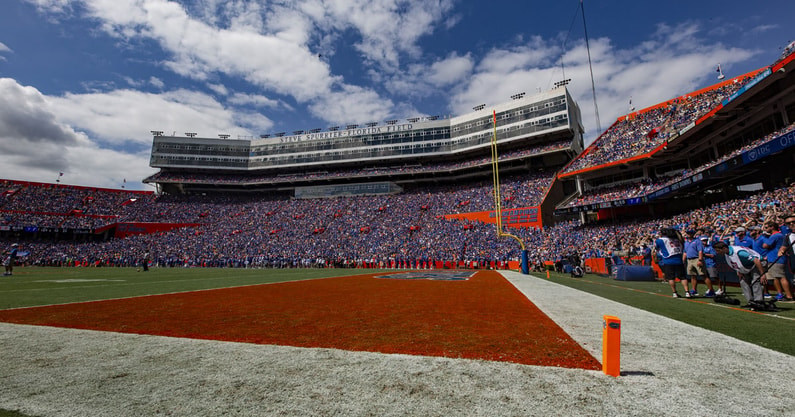Florida AD Scott Stricklin addresses reduced capacity in Swamp renovation he dubs 'most ambitious project in the history of college athletics'

Florida has been actively working on the idea of renovating the Swamp for the past several years, and things continue to progress on that front. Athletics director Scott Stricklin provided an update Tuesday on what he is calling “the most ambitious project in the history of college athletics.”
The head man at Florida joined the Gator Nation Football Podcast and spent more than an hour chatting about various topics. Naturally the Swamp came up.
At a high level, Stricklin is promising a thoroughly upgraded experience for the fans when all is complete. He explained.
“I can tell you that from a fan standpoint you’re going to have the same experience in the bowl, the stadium is going to be louder, the concourses are going to be wider, they’ll have more and better concessions, more and better restrooms, the outside’s going to look a lot more unified, the video boards will be bigger, they’ll be wider, you’ll have more square footage, you’ll have more ribbon boards, you’ll have better audio and sound,” Stricklin said. “Everything that touches a fan they’ll be able to enjoy. There will be a new structure built to accommodate some of the seat loss that the ADA code will impact.
“But it’s going to be the most ambitious project in the history of college athletics. And I think it’s going to be a model — once we accomplish it — that all these schools that have 100-year-old stadiums are going to come look at and try to figure out how we did it, because I think it’s going to be really impactful and it’s something Gators are going to feel really good about for a long time.”
One major concern most Florida fans have is the reported loss of seating capacity that will accompany the project. Stricklin explained that there’s basically no way around that.
He noted that as soon as Florida begins any major renovation to the main seating areas it must be in complete compliance with updated Americans with Disabilities Act regulations. That will force the loss of thousands of seats in the Swamp.
“That’s just a reality that we’re dealing with,” Stricklin said. “That’s not something I dreamed up. But we have an option. We can sit there and just not touch it and let it fall into disrepair or we can finally address it and try to do something in a thoughtful manner that makes the Swamp stay the Swamp and try to minimize that impact as much as possible.”
Top 10
- 1New
Jim Harbaugh sued
Warde Manuel also named in lawsuit
- 2Hot
Top 25
EA Sports CFB 26 rankings
- 3
Big 12 Conference
Ends preseason media poll
- 4Trending
2025 MLB Mock Draft
New No. 1 overall, big shakeup
- 5
NCAA President salary
Charlie Baker salary revealed
Get the On3 Top 10 to your inbox every morning
By clicking "Subscribe to Newsletter", I agree to On3's Privacy Notice, Terms, and use of my personal information described therein.
So where do things currently stand with the Swamp renovations? Well, Stricklin outlined that, too, giving a timeline into the near future.
“We are in design/development phase,” he said. “There’s three phases when you’re in design. This is the second phase. We’ll wrap this up sometime in the fall. At that point we’ll have a really good sense on budget. We’ll have a really good sense on what we’ll actually do. And once we come up with a financing plan we’ll be ready to start sharing that with Gator Nation.”
As for why the project is being described as the most ambitious one in the history of college athletics, Stricklin provided a few clarifications when pressed by the GNFP hosts. It’s less about the actual features of the renovation and more about the cost of the project.
It’s a significant undertaking. Florida will be renovating all four sides of the stadium, he said. That’s in contrast with the $350 million renovation Florida State is undergoing, that mainly addresses one side of the stadium. It’s also different than the complete teardown job Texas A&M did about a decade back.
“Most schools would do a master plan and take 10-15 years for what we need to do,” Stricklin said. “And we may get to a point from a financing standpoint that’s what we need to do. But the hope is we can do it all at one time. So that right there is going to make it dramatic. …
“I’m talking about from a dollars standpoint what we’re going to be doing is most ambitious. We’re not tearing down and rebuilding like A&M did, that was pretty ambitious. So I guess it’s all in a manner of how you use it. But I think it’s going to be transformational.”